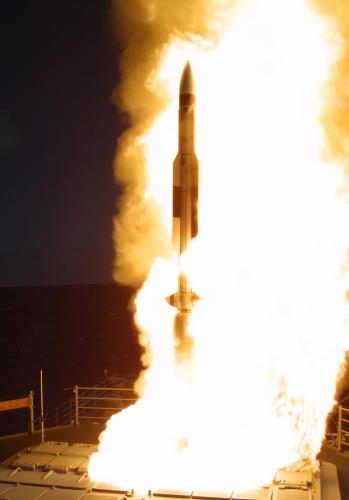US missile intercepts falling satellite
21 Feb 2008
 Washington: The US Navy has successfully intercepted a spy satellite that was plummeting from space to Earth, with the help of a modified Standard Missile-3 (SM-3). The US department of defence has said previously that the interception was meant to prevent the release of a cloud of toxic gas from about 1,000 pounds of frozen, toxic hydrazine propellant stored onboard the failed reconnaissance satellite.
Washington: The US Navy has successfully intercepted a spy satellite that was plummeting from space to Earth, with the help of a modified Standard Missile-3 (SM-3). The US department of defence has said previously that the interception was meant to prevent the release of a cloud of toxic gas from about 1,000 pounds of frozen, toxic hydrazine propellant stored onboard the failed reconnaissance satellite.
The satellite had malfunctioned immediately after launch in December 2006.
According to reports, USS Lake Erie, operating in the Pacific Ocean west of Hawaii, fired the missile.
"A network of land-, air-, sea- and space-based sensors confirms that the US military intercepted a non-functioning National Reconnaissance Office satellite which was in its final orbits before entering the Earth's atmosphere," a US department of defence statement said.
"At approximately 10:26 p.m. EST today, a US Navy AEGIS warship, the USS Lake Erie, fired a single modified tactical SM-3, hitting the satellite approximately 247 kilometres (133 nautical miles) over the Pacific Ocean as it travelled in space at more than 17,000 mph."
It was not clear to the authorities whether the missile had hit the satellite's full fuel tank, and according to the department of defence, it would be another 24 hours before they would know whether the fuel tank had been hit.
The fuel tank was the primary target of the missile. The SM-3 didn't carry a warhead, relying instead on a kinetic ''hit-to-kill'' principle to destroy the target. The authorities said that the impact of the SM-3 was expected to be sufficient to destroy the fuel tank.
The missile would have released a "kinetic kill vehicle," enabling it to "see" the satellite and adjust its course toward it if necessary, officials said.
"Debris will begin to re-enter the Earth's atmosphere immediately," the department said. "Nearly all of the debris will burn up on re-entry within 24-48 hours and the remaining debris should re-enter within 40 days."
The US Navy had just a 10-second window to fire, and officials had said they might not be able to fire at the first opportunity. However, the 10-second window would have been available on each of the next nine or 10 days.
The missile intercept would have cost up to $60 million, according to some estimates.
On its own the satellite would have fallen to Earth in early March, according to officials. This was considered to be particularly hazardous as the satellite had a full tank of toxic hydrazine propellant, which could have survived re-entry.
Hydrazine resembles chlorine or ammonia in that it affects the lungs and breathing tissue.
The intercept was timed so that resulting debris would tumble into the atmosphere and not interfere with other satellites, according to experts. The timing was also intended to minimize the chances that debris would hit populated areas.
It is now being revealed that a team of 200 industry experts and scientists had been hard at work since January to modify the Aegis air-defence missile system, which would allow it to shoot down the satellite. Amongst other things, the SM-3's sensors needed to be modified so that it could detect a much cooler satellite rather than the heat from an incoming missile or a warhead, which it was designed to do.
In January 2007, China carried out a anti-satellite test to destroy a 2,200-pound defunct satellite orbiting 528 miles above the Earth. According to NASA estimates the impact left more than 100,000 pieces of debris orbiting the planet - 2,600 of them more than 4 inches across.
Both Russia and China have expressed their apprehension that the destruction of the US satellite is essentially a disguised anti-satellite test.













.jpg)






.jpg)









